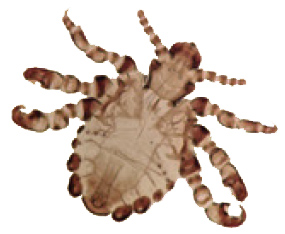Pthirus gorillae
Species of louse that infests gorillas
Pthirus gorillae is a species of louse that primarily infests gorillas. It is closely related to Pthirus pubis, the human pubic louse, and both species belong to the genus Pthirus. Pthirus gorillae is an ectoparasite, meaning it lives on the outside of its host, feeding on blood.
Taxonomy[edit | edit source]
Pthirus gorillae is part of the order Phthiraptera, which encompasses all lice. Within this order, it belongs to the family Pthiridae. The genus Pthirus is characterized by its crab-like appearance, with a broad, flat body and strong claws adapted for grasping the hair of its host.
Morphology[edit | edit source]
Pthirus gorillae exhibits a morphology similar to that of Pthirus pubis. It has a robust, flattened body that allows it to navigate through the dense hair of its host. The louse has six legs, each ending in a claw that is well-suited for clinging to hair shafts. Its body is divided into three parts: the head, thorax, and abdomen. The head contains specialized mouthparts for piercing the skin and sucking blood.
Life Cycle[edit | edit source]
The life cycle of Pthirus gorillae includes three stages: egg, nymph, and adult. The female louse lays eggs, known as nits, which are attached to the hair shafts of the host. These eggs hatch into nymphs, which undergo several molts before reaching adulthood. The entire life cycle can be completed in about a month, depending on environmental conditions.
Host and Habitat[edit | edit source]
Pthirus gorillae is specifically adapted to infest gorillas, particularly the eastern gorilla and western gorilla. These lice are typically found in the dense hair of their host, where they are protected from environmental conditions and predators. The louse's habitat is limited to the geographical range of its host, primarily in the forests of central Africa.
Transmission[edit | edit source]
Transmission of Pthirus gorillae occurs primarily through direct contact between gorillas. This can happen during social grooming, mating, or any other close physical interaction. The louse can also be transferred from mother to offspring during nursing or other close contact.
Evolutionary Significance[edit | edit source]
The close relationship between Pthirus gorillae and Pthirus pubis provides insights into the evolutionary history of lice and their hosts. It is believed that the two species diverged from a common ancestor that infested the common ancestor of humans and gorillas. This divergence likely occurred millions of years ago, coinciding with the evolutionary split between the lineages leading to modern humans and gorillas.
Related pages[edit | edit source]
Search WikiMD
Ad.Tired of being Overweight? Try W8MD's physician weight loss program.
Semaglutide (Ozempic / Wegovy and Tirzepatide (Mounjaro / Zepbound) available.
Advertise on WikiMD
|
WikiMD's Wellness Encyclopedia |
| Let Food Be Thy Medicine Medicine Thy Food - Hippocrates |
Translate this page: - East Asian
中文,
日本,
한국어,
South Asian
हिन्दी,
தமிழ்,
తెలుగు,
Urdu,
ಕನ್ನಡ,
Southeast Asian
Indonesian,
Vietnamese,
Thai,
မြန်မာဘာသာ,
বাংলা
European
español,
Deutsch,
français,
Greek,
português do Brasil,
polski,
română,
русский,
Nederlands,
norsk,
svenska,
suomi,
Italian
Middle Eastern & African
عربى,
Turkish,
Persian,
Hebrew,
Afrikaans,
isiZulu,
Kiswahili,
Other
Bulgarian,
Hungarian,
Czech,
Swedish,
മലയാളം,
मराठी,
ਪੰਜਾਬੀ,
ગુજરાતી,
Portuguese,
Ukrainian
Medical Disclaimer: WikiMD is not a substitute for professional medical advice. The information on WikiMD is provided as an information resource only, may be incorrect, outdated or misleading, and is not to be used or relied on for any diagnostic or treatment purposes. Please consult your health care provider before making any healthcare decisions or for guidance about a specific medical condition. WikiMD expressly disclaims responsibility, and shall have no liability, for any damages, loss, injury, or liability whatsoever suffered as a result of your reliance on the information contained in this site. By visiting this site you agree to the foregoing terms and conditions, which may from time to time be changed or supplemented by WikiMD. If you do not agree to the foregoing terms and conditions, you should not enter or use this site. See full disclaimer.
Credits:Most images are courtesy of Wikimedia commons, and templates, categories Wikipedia, licensed under CC BY SA or similar.
Contributors: Prab R. Tumpati, MD

